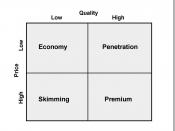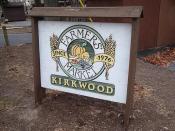Report Title: Pricing a Pinta Date: 13/05/02 INTRODUCTION This report is intended to give the readers an insight into the pricing theories and why they are used by firms, in the report, issues such as factors influencing the price of milk from farmers' perspectives and the battle between the doorstep milk delivery service and supermarkets are highlighted. Also the role the Milk Marque is questioned and analysed.
1.0 TERMS OF REFRENCE This report is concerned with factors that influence pricing decisions; the report is based upon a case study called "Pricing a Pinta", but one is required to carry out research and present genuine information in the report.
2.0 PROCEDURE In order to find the information needed to complete this report successfully, the methods that were adopted were: 2.1 Internet research 2.2 Marketing textbooks 2.3 Introduction to marketing case studies book 3.0 FINDINGS 3.1 Internal and external; factors affecting the price of milk for the farmers point of view.
3.1.1 Internal factors From the farmers' perspectives, there are many internal as well as external factors that influence the price of milk, the internal ones include supplying food and shelter for the cows used to supply the milk, during the summer period cows consume grass, however, during the winter, farmers need to purchase food for their cattle as well as arrange a suitable shelters for the animals.
Also the cow's health is important to the farmers, according to the Agricultural department, a farmer pays an average ã44 a year on vet's cost per cow, also hygiene factors must be considered by farmers adding to the variable costs sustained by the farmers.
It is also worth mentioning that some farmers employ workers which will also affect the cost of production of milk.
The farmer has to consider the breeding costs and buying the cows which is a major chunk of the farmers' cost, all of the mentioned factors contribute to high costs incurred by the farmer and therefore the farmer will need to sell the milk at a high price to make a profit, even if it is insignificant as the farmer needs the profit to survive.
To keep the price of milk down the government offers subsidies to farmers, such subsidies can also be considered as external factors, but since they have an immediate impact on the cost of production, it can also be counted as an internal factor.
3.1.2 External factors There are various the external factors that influence the price of milk from the farmers' perspectives including the actual demand for milk; recent surveys show that the demand for milk is declining slightly as milk is widely perceived as a boring commodity. However, The Dairy Council has been running a campaign called "the white stuff", the aim of the campaign is to boost the level of demand for milk by highlighting its benefits, and the campaign was indorsed by many celebrities including Prince Naseem Hamed, George Best and Chris Eubank.
Also supermarket and dairies have great negotiation and bargaining power when it comes to buying from farmers due to their economies of scale, also the laws and regulations set by the government add to the production cost.
However, the milk marque group, unites farmers for a collective bargaining power, so when selling the milk, the group ensures that the milk is sold for the best possible price providing the farmers make a decent return.
Technological and medical changes also play a key external role, which has its influence on the price of milk, thanks to better breeding and better nutrition, average milk yields have increased steadily over the years. The dairy cow of today produces more than twice the amount of milk per year than her ancestor did at the end of the Second World War and 1,200 litres more than a dairy cow 20 years ago and now one dairy cow produces 10,409 pints of milk in a year, enough to supply22 families with their daily milk. Such changes mean that the cost of milk a farmer sells to the dairy is relatively low as the supply per cow is increasing.
3.2 Pricing strategy used by supermarkets when selling milk When it comes to pricing milk, supermarket use a competitive pricing strategy, one can easily see that nearly all supermarkets charge the same price for milk, if a supermarket breaks the trend, others react accordingly.
According to the case study, milk is widely used by supermarkets as a loss leader; The loss leader is a pricing strategy which involves selling products/services at a price that will generate little or no profit and in some cases not even cover all associated costs (marketing, overheads, direct costs, etc). This may sound imprudent but it is a technique that is commonly used to attract customers to their business via a bargain. These bargains will attract customers to the business who may then purchase other products/services even if they don't buy the product that was initially reduced. This is where the business will make up for the loss, as it will be selling other items that generate high profits.
The loss leader strategy is normally used to encourage sales on those products that are in the decline stages of their life cycle (becoming un-fashionable or out-dated, etc). In which case, supermarkets may want to cut the price of such products to sell-off stock that isn't moving well and therefore be satisfied with the outcome of breaking even with the products (or with a small loss), but an increase in cash flow.
According to the report, supermarkets often make a figure of around 2p gross profit margin per pint, which is not adequate to cover the cost of storage or keeping the milk chilled, however the milk is used to sell other products, by strategically placing the milk section at the end of the store, customers go through shelves which contain other product which could attract customers, those products are usually sold at a higher profit margin and therefore covering the losses that might have been incurred by the milk.
Also a great advantage gained by supermarkets when selling the milk as a loss leader is the fact creates a reputation building for the supermarkets as a value-for-money business as people will associate you with 'good quality for less money.
Also supermarkets use an aggressive pricing strategy to discourage new firms from entering the market as well as destroying competitors' sales, and such action is quite clearly serving its purpose as the supermarkets' market share is increasing every year causing a decline on the doorstep delivery market share.
3.3 Threats to doorstep delivery companies, steps taken to counteract the threats and a what the companies could do 3.3.1 Threats From the case study given, one can clearly see that the main threat confronting the doorstep delivery companies is the obvious decline of their share of the market, according to the case study, their market share has constantly been declining and the slumping trend might continue. The decline is caused by the supermarket's dominance of the market due to their bargaining power and economies of scale; the case study suggests that the average price differential between doorsteps and supermarkets is 14p per pint. Modern day customers are known to be barging hunters and therefore they might prefer to buy from supermarkets to in order to save. the doorstep delivery companies employ around 20000 to make the deliveries, pick up the bottles and collect the money from individual households, on the other hand the supermarkets buy in bulk, deliver to branches and allow customers to help themselves. It is clear to see that the supermarkets are more cost effective, and that is the reason behind the different prices charged.
Also the fact that supermarkets are more convenient as customers can buy milk when they wish unlike the fixed style of doorstep delivery, this is supported by the statement mentioned by Mintel that claims that smaller households have more erratic consumption patterns, and thus buying from supermarkets is more convenient. Furthermore, the increase in milk life means that customers can buy a bottle that contains 6 pints of milk and it will occupy less room in the fridge than the equivalent number of glass bottles would.
3.3.2 Steps to counteract To put an end to the constant decline in the market share, doorstep delivery companies along with Milk Marque launched a magazine called Home and Life, the magazine's price was a ã1 an issue and its first issue sold 350,000 copies.
However the demand for the magazine has declined rapidly and the idea was soon scrapped.
Also one of the leading doorstep companies (Dale Farm Express) entered an agreement with Lever Brothers and Kellogg to deliver bulky fmcg products to homes on the milk round and the idea was failed miserably. The milk delivering companies also tried running promotions and competition to create consumer loyalty.
Finally, according to Dale Farm Express website, the company seems to have used the " if you can't beat them then join them" approach as it began working hand in hand with supermarkets, the company claims, "Express is the UK's largest supplier of fresh milk to the leading multiple retailers, delivering to around 1,200 individuals supermarkets daily". Such statement implies the link between them, and it guarantees the Dale Farm Express sales as supermarkets have buyer power.
3.3.3 Suggestions for improvement To boost demand the doorstep delivery companies could employ the use of plastic bottles instead of the traditional glass bottles, as they are more user friendly and they take less space in the fridge, also being more flexible with consumer needs could help, as that will be more convenient to customer with erratic milk consumption patterns.
The companies could also invest in organic milk, as people are becoming more health conscious and the demand for organic products is constantly rising. The doorstep delivery companies could also sell other goods such as chocolate bars and soft drinks at competitive or cheap prices, such a move will be of a convenient to consumers and it could build a relationship with the consumers.
3.4 The role of Milk Marque and what might happen if Milk Marque did not exist The Milk Marque organisation exists to protects the farmers' interest and it acts as a trade union for farmers' by ensuring the farmers' get the best possible deals from dairies. The Milk Marque also aimed to increase the price of the milk sold to dairies that resulted in an increase between 8 to 11% in milk prices.
By working for farmers' needs the Milk Marque helps standardise the supply quality, also by making farmers' work together for one cause, the Milk Marque allows them all to benefit instead of competing with one another causing losses to at least one party. It gives farmers' negotiation power when negotiating prices with dairies or supermarkets.
However, the Milk Marque owned a lot of the milk supply and had to be investigated by the Monopolies and Mergers Commission as evidence were showing that the organisation was involved in unfair trading. Shortly after being investigated, the Milk Marque announced a plan for structural reform. It proposed to split itself into three successor organisations controlling three different regions; The Minister of Agriculture Nick Brown, who said it was a positive move, welcomed the news in late 1999.
If Milk Marque did not exist, it would be bad news for farmers' as they will all be competing with one another for the sale of milk, it would also be hard to get decent price for their milk as they will not have negotiation power. Also it would be hard for supermarkets and dairies to get their milk supply from more than one source which is bound to increase prices, meaning the milk might not be sold as a loss leader.
4.0 CONCLUSION Although the price of milk is cheap to some extent, there are many factors which influence it, for example factors influencing farmers' will naturally have an impact on the final price of milk, factors such as the farmers' costs and government subsidies allowed to farmers contribute to the price the farmers' ask for from dairies.
Supermarkets and doorstep delivery companies both have different methods of pricing their milk, supermarket buy in bulk which allows them the benefits of discounts and therefore they can afford to sell the milk for cheaper prices.
Doorstep deliveries, by in large quantities but have to hire people to deliver, collect bottles and collect money from households making their prices higher due to the service they provide.
Experts predict that the market share for supermarkets is set to continue causing a decline in the doorstep deliveries market share, both styles suit different individuals, the doorstep delivery companies might have lost a great deal of market share, but as long and there is milk, there will always going be people supporting the traditional idea of milkmen.
5.0 REFERENCE To complete this report several sources were used including: 5.1 Books ÷ Business Studies for A level (Stephen Danks) ÷ Marketing Textbook (Brassington an Pettitt) 5.2 Case studies book 5.3 Internet Sites ÷ http://www.kingshay.co.uk/services/dairymanager/images/fullcostvar.gif ÷ http://www.pbs.org/ktca/newtons/11/dairyfrm.html ÷ http://test.corporateinformation.com/memberlogin.asp ÷ http://www.shakey-jake.co.uk/aboutexpress/ae_factsandfigures.html ÷ http://www.milk.co.uk





